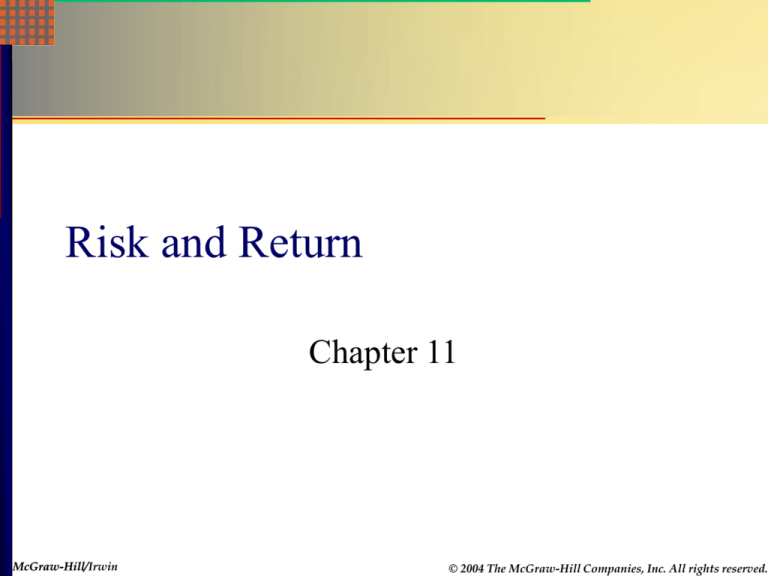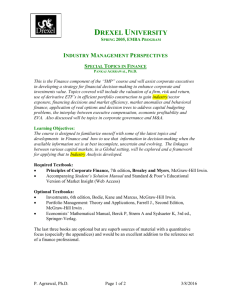
Risk and Return
Chapter 11
McGraw-Hill
McGraw-Hill/Irwin
© 2004 The McGraw-Hill Companies, Inc. All rights reserved.
Chapter Outline
1.
2.
3.
4.
Portfolio Return and Variance
Diversification and Systematic and Unsystematic
Risk
Systematic Risk and Beta
The Security Market Line and CAPM
11.1
McGraw-Hill
McGraw-Hill/Irwin
© 2004 The McGraw-Hill Companies, Inc. All rights reserved.
1. Portfolios
A portfolio
is a collection of assets
The risk-return trade-off for a portfolio is
measured by the portfolio return and standard
deviation, just as with individual assets
11.2
McGraw-Hill
McGraw-Hill/Irwin
© 2004 The McGraw-Hill Companies, Inc. All rights reserved.
Example: BP & DD Portfolio
11.3
McGraw-Hill
McGraw-Hill/Irwin
© 2004 The McGraw-Hill Companies, Inc. All rights reserved.
Portfolio Return
We
invested in a portfolio consisted equally of
two stocks, BP and DD, for one year.
Return(% )
Std. Dev.(% )
What
BP(1/2)
0.35
2.88
DD(1/2)
-0.33
2.95
Portfolio
0.01
is return of the portfolio?
RP w1 R1 w2 R2
=(1/2)*(0.35)+(1/2)*(-0.33) = 0.01
11.4
McGraw-Hill
McGraw-Hill/Irwin
© 2004 The McGraw-Hill Companies, Inc. All rights reserved.
Portfolio Standard Deviation
We
invested in a portfolio consisted equally of
two stocks, BP and DD, for one year.
Return(% )
Std. Dev.(% )
BP(1/2)
0.35
2.88
DD(1/2)
-0.33
2.95
Portfolio
0.01
2.47
What
is the portfolio standard deviation?
Note that portfolio Std. Dev. does NOT equal to
(1/2)*(2.88)+(1/2)*(2.95)= 2.92,
and 2.47 < 2.92
11.5
McGraw-Hill
McGraw-Hill/Irwin
© 2004 The McGraw-Hill Companies, Inc. All rights reserved.
2. Diversification
Portfolio diversification is the investment in
several different asset classes or sectors
Diversification is not just holding a lot of assets
For example, if you own 50 internet stocks, you are
not diversified
If you own 50 stocks that span 20 different
industries, then you are diversified
11.6
McGraw-Hill
McGraw-Hill/Irwin
© 2004 The McGraw-Hill Companies, Inc. All rights reserved.
Diversification
Diversification
can substantially reduce the
variability of returns without an equivalent
reduction in expected returns, so some part of
the variability of returns is not rewarded in the
market
There is a reward for bearing risk
There is not a reward for bearing risk
unnecessarily
11.7
McGraw-Hill
McGraw-Hill/Irwin
© 2004 The McGraw-Hill Companies, Inc. All rights reserved.
Weekly Returns of DJIA
Return(% )
Std. Dev.(% )
BP(1/2)
0.35
2.88
DD(1/2)
-0.33
2.95
Portfolio
0.01
2.47
DJIA
0.02
1.48
11.8
McGraw-Hill
McGraw-Hill/Irwin
© 2004 The McGraw-Hill Companies, Inc. All rights reserved.
2.1 Total Risk
Total
risk = systematic risk + unsystematic risk
The standard deviation of returns is a measure of
total risk
11.9
McGraw-Hill
McGraw-Hill/Irwin
© 2004 The McGraw-Hill Companies, Inc. All rights reserved.
Systematic Risk
The risk that cannot be eliminated by
combining assets into a portfolio
Often considered the same as undiversifiable
risk, generated from such things as changes in
GDP, inflation, interest rates, etc.
11.10
McGraw-Hill
McGraw-Hill/Irwin
© 2004 The McGraw-Hill Companies, Inc. All rights reserved.
Unsystematic Risk
The
risk that can be eliminated by combining
assets into a portfolio
Often considered the same as diversifiable,,
unique or asset-specific risk, generated from
such asset-specific things as labor strikes, part
shortages, etc.
If we hold only one asset, or assets in the same
industry, then we are exposing ourselves to risk
that we could diversify away
11.11
McGraw-Hill
McGraw-Hill/Irwin
© 2004 The McGraw-Hill Companies, Inc. All rights reserved.
2.2 Risk and Return Principle
The
expected return on a risky asset depends
only on that asset’s systematic risk since
unsystematic risk can be diversified away
For well diversified portfolios, unsystematic risk
is very small
Consequently, the total risk for a diversified
portfolio is essentially equivalent to the
systematic risk, this is why the standard
deviation of a diversified portfolio is smaller
than that of a specific asset
11.12
McGraw-Hill
McGraw-Hill/Irwin
© 2004 The McGraw-Hill Companies, Inc. All rights reserved.
The Principle of Diversification
1.
2.
3.
Diversification can substantially reduce the
variability of returns without an equivalent reduction
in expected returns
This reduction in risk arises because worse than
expected returns from one asset are offset by better
than expected returns from another
However, there is a minimum level of risk that cannot
be diversified away and that is the systematic portion,
generated from such things as changes in GDP,
inflation, interest rates, etc.
11.13
McGraw-Hill
McGraw-Hill/Irwin
© 2004 The McGraw-Hill Companies, Inc. All rights reserved.
Portfolio Diversification
Return(% )
Std. Dev.(% )
BP(1/2)
0.35
2.88
DD(1/2)
-0.33
2.95
Portfolio
0.01
2.47
DJIA
0.02
1.48
SP500
0.10
1.38
11.14
McGraw-Hill
McGraw-Hill/Irwin
© 2004 The McGraw-Hill Companies, Inc. All rights reserved.
Historical Returns, Standard Deviations, and
Frequency Distributions: 1926-2004
How can we measure the systematic risk of single stock?
11.15
McGraw-Hill
McGraw-Hill/Irwin
© 2004 The McGraw-Hill Companies, Inc. All rights reserved.
3. Measuring Systematic Risk
How
do we measure systematic risk?
We use the beta coefficient to measure
systematic risk
What does beta tell us?
A beta of 1 implies the asset has the same systematic
risk as the overall market
A beta < 1 implies the asset has less systematic risk
than the overall market
A beta > 1 implies the asset has more systematic risk
than the overall market
11.16
McGraw-Hill
McGraw-Hill/Irwin
© 2004 The McGraw-Hill Companies, Inc. All rights reserved.
Weekly Returns of DJIA
11.17
McGraw-Hill
McGraw-Hill/Irwin
© 2004 The McGraw-Hill Companies, Inc. All rights reserved.
Beta Coefficients for Selected
Companies
Du Pont
BP
1.22
1.41
11.18
McGraw-Hill
McGraw-Hill/Irwin
© 2004 The McGraw-Hill Companies, Inc. All rights reserved.
Sample Question 1: Total versus
Systematic Risk
Consider
the following information:
Security C
Security K
Standard Deviation
20%
30%
Beta
1.25
0.95
Which
security has more total risk?
Which security has more systematic risk?
Which security should have the higher expected
return?
11.19
McGraw-Hill
McGraw-Hill/Irwin
© 2004 The McGraw-Hill Companies, Inc. All rights reserved.
Sample Question 2: Portfolio Weights
Suppose
you have $15,000 to invest and you
have purchased securities in the following
amounts. What are your portfolio weights in
each security?
$2000 of DCLK
$3000 of KO
$4000 of INTC
$6000 of KEI
•DCLK: 2/15 = .133
•KO: 3/15 = .2
•INTC: 4/15 = .267
•KEI: 6/15 = .4
11.20
McGraw-Hill
McGraw-Hill/Irwin
© 2004 The McGraw-Hill Companies, Inc. All rights reserved.
Sample Question 2: Expected
Portfolio Returns
Consider the portfolio weights computed previously. If
the individual stocks have the following expected
returns, what is the expected return for the portfolio?
DCLK: 19.65%
KO: 8.96%
INTC: 9.67%
KEI: 8.13%
E(RP) = .133(19.65%) + .2(8.96%) + .167(9.67%) +
.4(8.13%) = 9.27%
11.21
McGraw-Hill
McGraw-Hill/Irwin
© 2004 The McGraw-Hill Companies, Inc. All rights reserved.
Sample Question 2: Portfolio Betas
Consider the previous example with the following four
securities
Security
DCLK
KO
INTC
KEI
Weight
.133
.2
.267
.4
Beta
4.03
0.84
1.05
0.59
What is the portfolio beta?
.133(4.03) + .2(.84) + .267(1.05) + .4(.59) = 1.22
11.22
McGraw-Hill
McGraw-Hill/Irwin
© 2004 The McGraw-Hill Companies, Inc. All rights reserved.
4.Capital Asset Pricing Model
The
capital asset pricing model (CAPM) defines
the relationship between risk and return
E(RA) = Rf + A(E(RM) – Rf)
If we know an asset’s systematic risk, we can
use the CAPM to determine its expected return
This is true whether we are talking about
financial assets or physical assets
11.23
McGraw-Hill
McGraw-Hill/Irwin
© 2004 The McGraw-Hill Companies, Inc. All rights reserved.
Example - CAPM
Consider
the betas for each of the assets given
earlier. If the risk-free rate is 6.15% and the
market risk premium is 9.5%, what is the
expected return for each?
Security
DCLK
KO
INTC
KEI
4.03
0.84
1.05
0.59
Beta Expected Return
6.15 + 4.03(9.5%) = 44.435%
6.15 + .84(9.5%) = 14.13%
6.15 + 1.05(9.5%) = 16.125%
6.15 + .59(9.5%) = 11.755%
11.25
McGraw-Hill
McGraw-Hill/Irwin
© 2004 The McGraw-Hill Companies, Inc. All rights reserved.
Security Market Line
30%
Expected Return
25%
E(RA)
20%
E(RM)
15%
10%
Rf
5%
0%
0
0.5
1
1.5 A
2
2.5
3
Beta
11.26
McGraw-Hill
McGraw-Hill/Irwin
© 2004 The McGraw-Hill Companies, Inc. All rights reserved.
Security Market Line
The
security market line (SML) is the
representation of market equilibrium
The slope of the SML is the reward-to-risk ratio:
risk premium
E ( RA ) R f
E ( RM R f )
amount of systematic risk
A
M
Since
the beta for the market is ALWAYS equal
to one, the slope can be rewritten:
Slope = E(RM) – Rf = market risk premium
11.27
McGraw-Hill
McGraw-Hill/Irwin
© 2004 The McGraw-Hill Companies, Inc. All rights reserved.
Review Questions
1. What is portfolio? How to calculate the expected return
of a portfolio?
2. What is the principle of diversification? Why
diversification works?
What is total risk? systematic risk? and unsystematic
risk? What are the other names for systematic and
unsystematic risk? What is the difference between
systematic and unsystematic risk?
What type of risk is relevant for determining the
expected return?
11.28
McGraw-Hill
McGraw-Hill/Irwin
© 2004 The McGraw-Hill Companies, Inc. All rights reserved.
Review Questions
3. What do variance and standard deviation of a stock
measure? What does a stock’s beta measure?
How to calculate the beta of a portfolio giving
information on betas of stocks made of the portfolio?
4. What is CAPM? What is security market line? What is
the reward-to-risk ratio?
Know how to calculate the expected return of a stock
using security market line or CAPM. Know how to
calculate the reward-to-risk ratio.
11.29
McGraw-Hill
McGraw-Hill/Irwin
© 2004 The McGraw-Hill Companies, Inc. All rights reserved.






